Fostering Social Skills in Children with Autism through Structured Turn-Taking Strategies
Understanding Response Cost and its Role in Behavior Management
In the realm of behavioral therapy, particularly within Applied Behavior Analysis (ABA), response cost emerges as a significant technique used to reduce undesirable behaviors. This article delves into what response cost is, how it functions within behavior management, and the contexts in which it is applied, especially in therapies addressing autism spectrum disorder (ASD). We will also explore the qualifications of therapists who implement such interventions, and how response cost fits into the broader spectrum of ABA strategies aimed at fostering meaningful and positive changes in behavior.
What is Applied Behavior Analysis (ABA) Therapy?

What is applied behavior analysis (ABA) therapy?
Applied Behavior Analysis (ABA) therapy is a scientific approach based on the study of learning and behavior. It focuses on understanding how behaviors work and are influenced by the environment, aiming to encourage positive behaviors while reducing harmful or obstructive ones. Typically used for individuals with autism spectrum disorder, ABA helps improve language, communication, attention, and social skills, tailoring programs to meet each person's unique needs.
What is the goal of ABA therapy?
The primary goal of ABA is to increase helpful behaviors — such as communication and social interaction — and decrease behaviors that interfere with learning or daily functioning. This is done to improve overall quality of life and foster greater independence.
How does ABA use scientific principles?
ABA uses principles of learning, using the Antecedent-Behavior-Consequence (A-B-C) model to analyze behavior. An antecedent triggers a behavior, and the consequence that follows influences whether that behavior will occur again. Positive reinforcement, where valued rewards follow desired behaviors, is a central strategy to encourage repetition of those behaviors.
What techniques are involved in ABA?
ABA therapy employs various techniques, including:
- Positive reinforcement to promote desired behaviors
- Careful observation to identify environmental triggers
- Tailored individual or group sessions in settings like home, school, or community
- Ongoing data collection and adjustment of strategies based on progress
How is ABA applied to autism and related challenges?
ABA is extensively used to support people with autism, addressing communication difficulties, social challenges, focus issues, and problem behaviors. Programs are designed around each child's interests and strengths, helping develop skills in a natural, motivating way. By breaking down complex skills into manageable steps, ABA promotes meaningful improvements that support learning and adaptation in daily life.
The Function and Mechanism of Response Cost in ABA
What is Response Cost in ABA?
Response cost is a behavioral technique used in Applied Behavior Analysis (ABA) that involves the removal of a previously earned reward or desirable item following undesired behavior. This method helps decrease behaviors that are harmful or impede learning by applying a consequence directly linked to the behavior.
How Does Response Cost Modify Behavior?
Response cost works by creating a clear connection between the behavior and its consequence. When a behavior results in losing a valued reinforcement, the likelihood of that behavior occurring again decreases. This negative consequence serves as a deterrent, encouraging the individual to adopt more helpful behaviors.
How Does Response Cost Relate to Reinforcement?
While positive reinforcement increases the probability of desired behaviors by delivering rewards after the behavior, response cost operates as a form of punishment by taking away rewards to reduce undesired behavior. Both strategies are integral components of the A-B-Cs model in ABA, where antecedents, behaviors, and consequences are analyzed and manipulated to shape behavior effectively.
Examples of Response Cost Usage
- A child earns tokens for completing tasks but loses tokens when engaging in aggression.
- A student who interrupts class loses free time privileges.
- A child who refuses to follow instructions may lose access to a preferred toy for a brief period.
By carefully applying response cost, therapists tailor interventions to individual needs, aiming to reduce problem behaviors while supporting positive skill development.
When is Response Cost Used: Practical Applications in Therapy
Situations That Call for Response Cost
Response cost is a behavioral strategy often employed within ABA therapy to reduce harmful or disruptive behaviors. It is particularly used when a behavior is socially significant but impedes learning or safety. For example, behaviors like aggression, self-injury, or non-compliance might call for this intervention to guide the individual toward more adaptive behaviors.
Target Behaviors for Reduction
The approach targets behaviors that interfere with an individual's progress, such as repeated tantrums, outbursts, or violating safety rules. These are behaviors that ABA aims to decrease to facilitate improved social interactions and learning outcomes.
Integration With Other ABA Methods
Response cost is typically integrated with positive reinforcement strategies. While ABA increases helpful behaviors using rewards, response cost involves the removal of a previously earned reinforcer contingent on inappropriate behavior. This combination helps balance encouraging good behaviors and discouraging unwanted ones. The A-B-Cs model—antecedent, behavior, consequence—guides when to apply response cost by focusing on the consequences that diminish the unwanted behavior.
Examples in Clinical and Educational Settings
In educational settings, response cost might involve losing a token or privilege when a child exhibits off-task behavior, helping reduce distractions and improve focus. Clinically, it can be part of behavior programs to decrease self-injury by removing preferred items or activities each time the behavior occurs. These strategies are individualized based on the child's needs and motivation, ensuring effective intervention.
By thoughtfully applying response cost within comprehensive ABA programs, therapists and educators can reduce barriers to learning and support positive behavior change.
Response Cost in Managing Autism Spectrum Behaviors
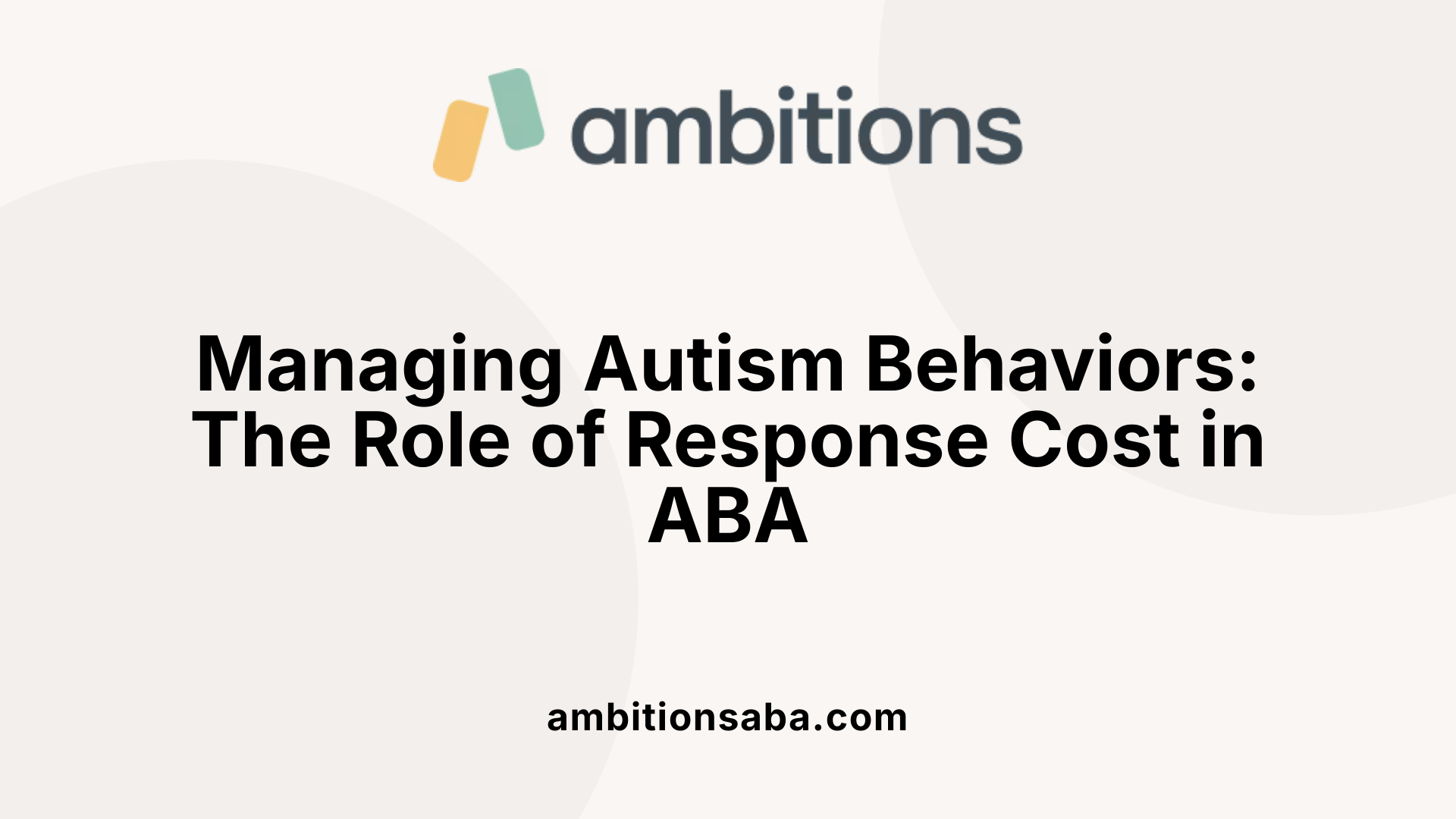
How Does ABA Therapy Help Individuals with Autism?
ABA (Applied Behavior Analysis) therapy is a scientifically grounded approach that enhances understanding of behavior by examining its causes and consequences. It is widely used in autism intervention to increase beneficial behaviors and reduce those that impede learning or cause harm. Through tailored programs, ABA therapy supports improvements in communication, social skills, attention, and academic performance by using individualized techniques such as positive reinforcement and analyzing the A-B-Cs of behavior — antecedents, behaviors, and consequences.
What Behavioral Challenges in Autism Are Addressed by Response Cost?
In autism spectrum disorder, children often experience difficulties with adaptability and social expectations, leading to behaviors like avoidance or meltdowns, especially seen in profiles like Pathological Demand Avoidance (PDA). Response cost helps manage such behaviors by introducing a system where certain inappropriate or interfering behaviors result in a specified loss of privilege or reward. This method targets behavior reduction by clearly linking consequences to actions, helping children gradually learn self-regulation and improved compliance with expectations.
How Does Response Cost Complement Positive Reinforcement?
While positive reinforcement encourages repetition of good behaviors by providing valued rewards, response cost provides an opposite but complementary approach where unwanted behaviors result in a loss of previously earned rewards or privileges. This dual system allows ABA therapy to provide consistent and balanced feedback. Positive behaviors are encouraged, and problem behaviors are discouraged through response cost, enabling clearer boundaries and enhancing learning outcomes for autistic individuals.
What Are the Benefits and Considerations of Response Cost in Autism Treatment?
Response cost, when integrated thoughtfully into ABA programs, can contribute to reducing challenging behaviors and improving cooperation, especially when paired with motivation-based strategies relevant to the child's interests. However, careful implementation is critical to avoid negative emotional responses. It should be used as part of a broader individualized intervention plan that includes collaboration with families, respect for the child's needs, and an emphasis on building adaptive and flexible coping skills.
Together, ABA therapy and response cost strategies form an effective framework for addressing the complexities of autism behaviors. This approach supports children in achieving greater independence, better social functioning, and enhanced quality of life.
The Role of Positive Reinforcement and Consequences in ABA
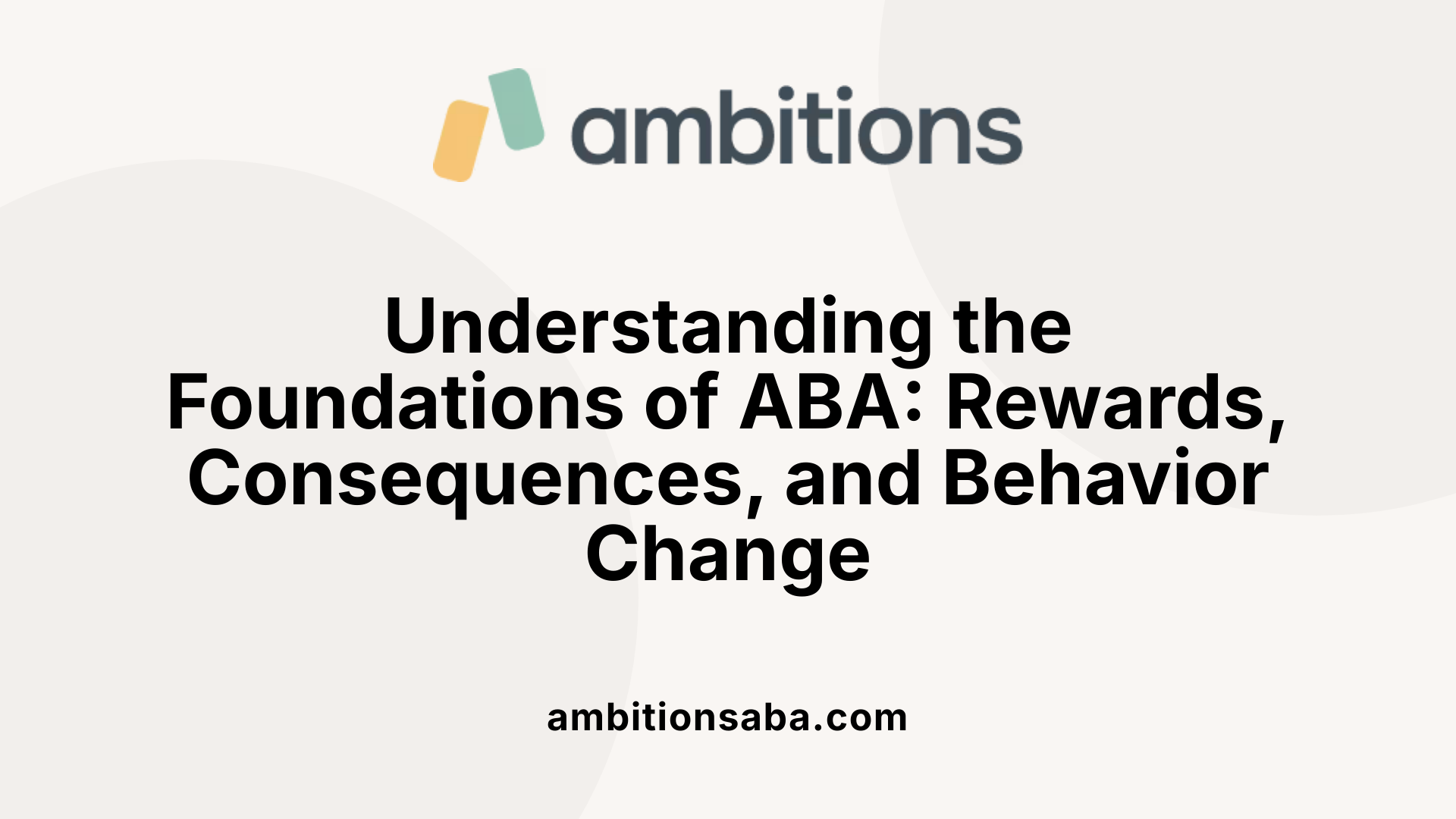
What is Positive Reinforcement in ABA?
Positive reinforcement is a fundamental strategy in Applied Behavior Analysis (ABA) therapy. It involves providing a valued reward immediately after a desired behavior occurs, which increases the likelihood that the behavior will be repeated. For example, a child might receive praise or a favorite activity after correctly following an instruction. This approach helps to encourage helpful behaviors by linking them to positive outcomes.
How Does the Antecedent-Behavior-Consequence (A-B-C) Model Work?
The A-B-C model is central to understanding and changing behavior in ABA. It breaks down behavior into three components:
- Antecedent: What happens right before the behavior — the trigger or cue.
- Behavior: The actual response or action from the individual.
- Consequence: What follows the behavior — either reinforcement to encourage it or no reaction to discourage it.
By analyzing these elements, therapists can identify what prompts behaviors and which consequences effectively encourage or reduce them.
How Do Consequences Shape Behavior?
Consequences in ABA serve to modify the likelihood of behaviors occurring again. When a positive consequence follows a desirable behavior, such as receiving a reward, it strengthens that behavior. Conversely, a lack of reinforcement or neutral response can decrease a behavior's frequency. Most ABA programs emphasize positive reinforcement over punishment because it promotes learning in a supportive way and reduces negative side effects.
Comparing Reinforcement and Punishment Strategies
While reinforcement aims to increase helpful behaviors by providing rewards, punishment involves applying a negative consequence to reduce unwanted behaviors. ABA therapy generally prioritizes positive reinforcement for building skills and minimizing harmful behaviors. Punishment strategies are less favored because they might lead to fear or avoidance rather than understanding. Effective ABA programs often use natural consequences and consistent reinforcement schedules to encourage lasting behavior change.
The Importance of Qualified Providers in Implementing Response Cost
Who typically provides ABA therapy services?
ABA therapy is typically delivered by trained and specialized professionals such as Board Certified Behavior Analysts (BCBAs), speech therapists, and members of interdisciplinary teams. These experts develop tailored, goal-oriented treatment plans based on behavioral science to support children with autism spectrum disorder (ASD) and related developmental delays. Services can be offered in diverse settings including clinics, homes, and schools. Caregiver training and parent coaching are often included to ensure skills generalize beyond therapy sessions.
What qualifications should therapists have to provide effective ABA therapy?
Effective ABA therapists usually hold at least a master's degree in Applied Behavior Analysis or a related field. Many have attained certification as a BCBA®, granted by the Behavior Analyst Certification Board (BACB). This certification requires completing 1,500 to 2,000 hours of supervised practical experience and passing a comprehensive exam. Therapists also need continuing education to stay current with advances. Licensure standards vary by state but typically encompass education, certification, and regular professional development.
Certification and ethical standards
Certification bodies like the BACB enforce strong ethical guidelines emphasizing respect, beneficence, and individualized care. Therapists must adhere to these codes to ensure treatment is delivered responsibly and safely. Standards cover assessment accuracy, intervention design, and maintaining client dignity.
Impact of therapist expertise on treatment outcomes
The therapist’s expertise profoundly influences the success of ABA therapy, including strategies like response cost. Competent therapists use evidence-based techniques such as positive reinforcement and carefully balance behavior reduction with skill-building. They skillfully apply the A-B-Cs model (antecedent, behavior, consequence) to analyze behavior and tailor interventions effectively. Higher qualifications and experience correlate with better treatment adherence, improved social and communication skills in clients, and sustained behavioral improvements.
| Role | Qualifications | Importance |
|---|---|---|
| BCBA® | Master's degree, certification, supervised hours | Ensures scientifically validated and ethical ABA delivery |
| Speech Therapists | Professional license and specialization | Supports communication goals within ABA framework |
| Caregivers and Parents | Trained by therapists | Promotes skill generalization and maintenance |
Qualified providers are essential to maximize ABA therapy benefits, ensuring interventions like response cost are applied effectively and ethically, tailored to individual needs.
Ethical Considerations and Best Practices in Employing Response Cost
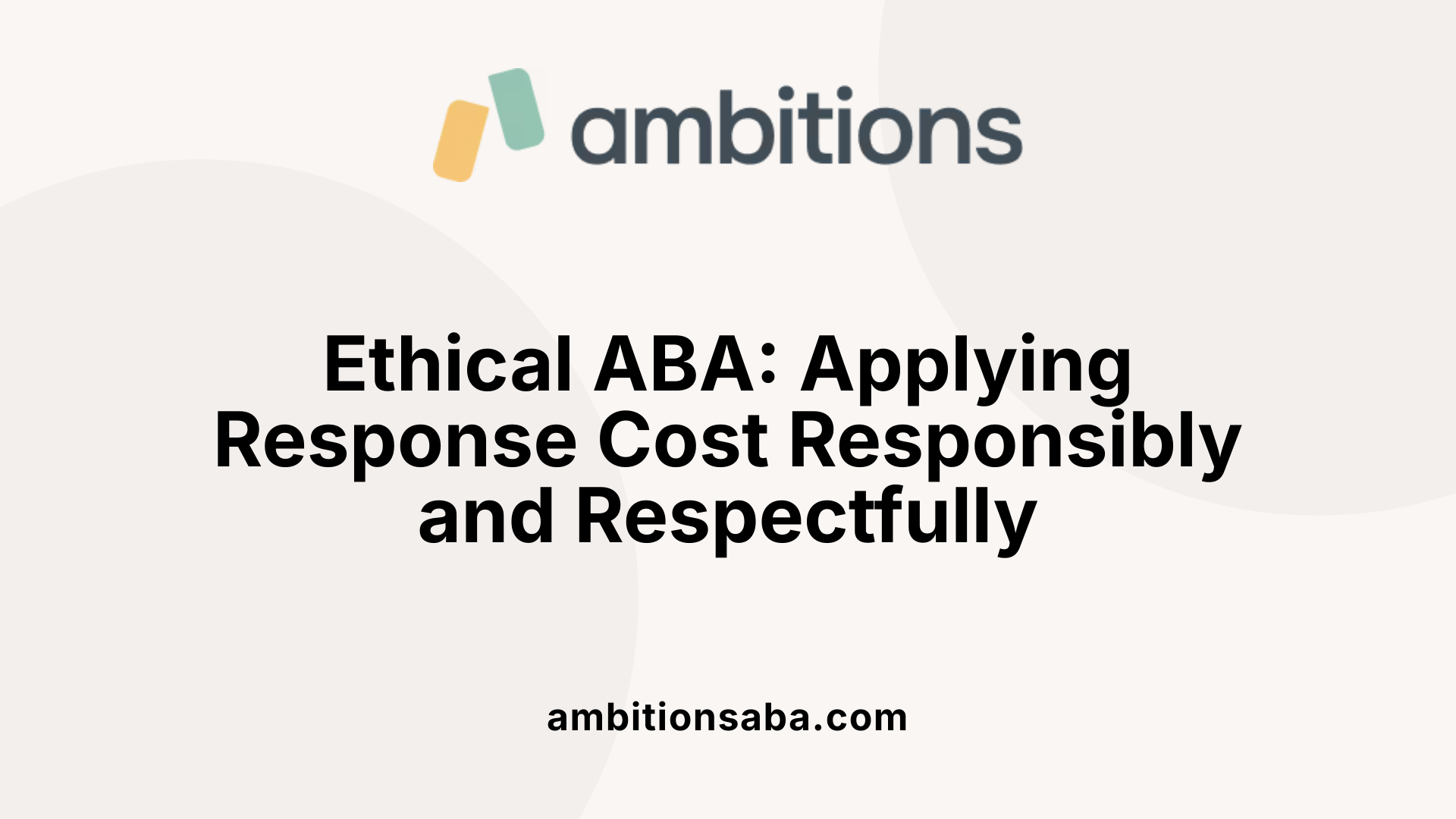
What are the ethical implications of behavior reduction?
Behavior reduction strategies like response cost must be applied thoughtfully to avoid harm. Unintended negative effects include increased anxiety or avoidance, especially in autistic individuals who may already face challenges with inflexibility and anxiety. Behavior reduction should never be punitive but aimed at supporting adaptive skills while respecting the individual's dignity.
How can reinforcement and punishment be balanced effectively?
ABA therapy emphasizes increasing helpful behaviors through positive reinforcement over punishing undesirable behaviors. Response cost, a form of behavioral consequence, should be balanced with ample use of reinforcement so the individual experiences motivation rather than fear. Reinforcement strengthens skills like communication and social interaction.
How to ensure dignity and respect in behavior interventions?
Interventions need to be individualized, considering what motivates the person and avoiding coercive or harsh demands. Collaboration, negotiation, and promoting flexibility help maintain respect for autonomy. Communication about why a behavior is targeted helps the individual feel understood and supported.
Why is monitoring and adjusting interventions important?
Ongoing assessment allows for tracking the individual's response to response cost and other techniques. Adjustments reduce risks of adverse reactions and help tailor approaches to evolving needs. Monitoring ensures interventions contribute to well-being and quality of life.
Ethical ABA interventions maintain a supportive environment focused on growth, respecting the person’s rights and comfort in line with global recommendations for inclusive care.
Tailoring Response Cost to Individual Needs in Autism
Individualized Behavior Plans
Response cost strategies in autism must be part of individualized behavior plans designed to meet each child's unique needs. These plans rely on detailed assessment of behaviors to determine what helpful behaviors to increase and harmful behaviors to reduce. Customization ensures that interventions are relevant and effective for the child’s developmental profile.
Assessment and Ongoing Progress Tracking
Ongoing assessment and progress tracking are essential to tailor response cost appropriately. Continuous monitoring helps adjust the intervention to the child's changing behavior and motivational levels, ensuring the strategy remains effective without causing undue stress.
Incorporation of Motivating Factors and Interests
For autism interventions, incorporating a child's interests is vital to enhance motivation. Children, especially those with Pathological Demand Avoidance (PDA), respond better when activities align with their personal interests and when demands are presented collaboratively rather than forcefully. Leveraging intrinsic motivation supports engagement and fosters positive behavioral changes.
Adaptation for Children with Pathological Demand Avoidance
Children with PDA require particular sensitivity in applying response cost strategies due to their heightened demand avoidance rooted in anxiety and cognitive rigidity. Interventions must use negotiation and flexible approaches rather than strict consequences. Building adaptive skills and flexibility helps reduce avoidance behaviors while respecting the child's need for autonomy.
Customizing response cost and other behavioral interventions within a supportive, child-driven framework can improve outcomes and quality of life for autistic children, respecting their individuality and promoting lasting positive changes.
Integrating Response Cost with Other Behavioral Interventions
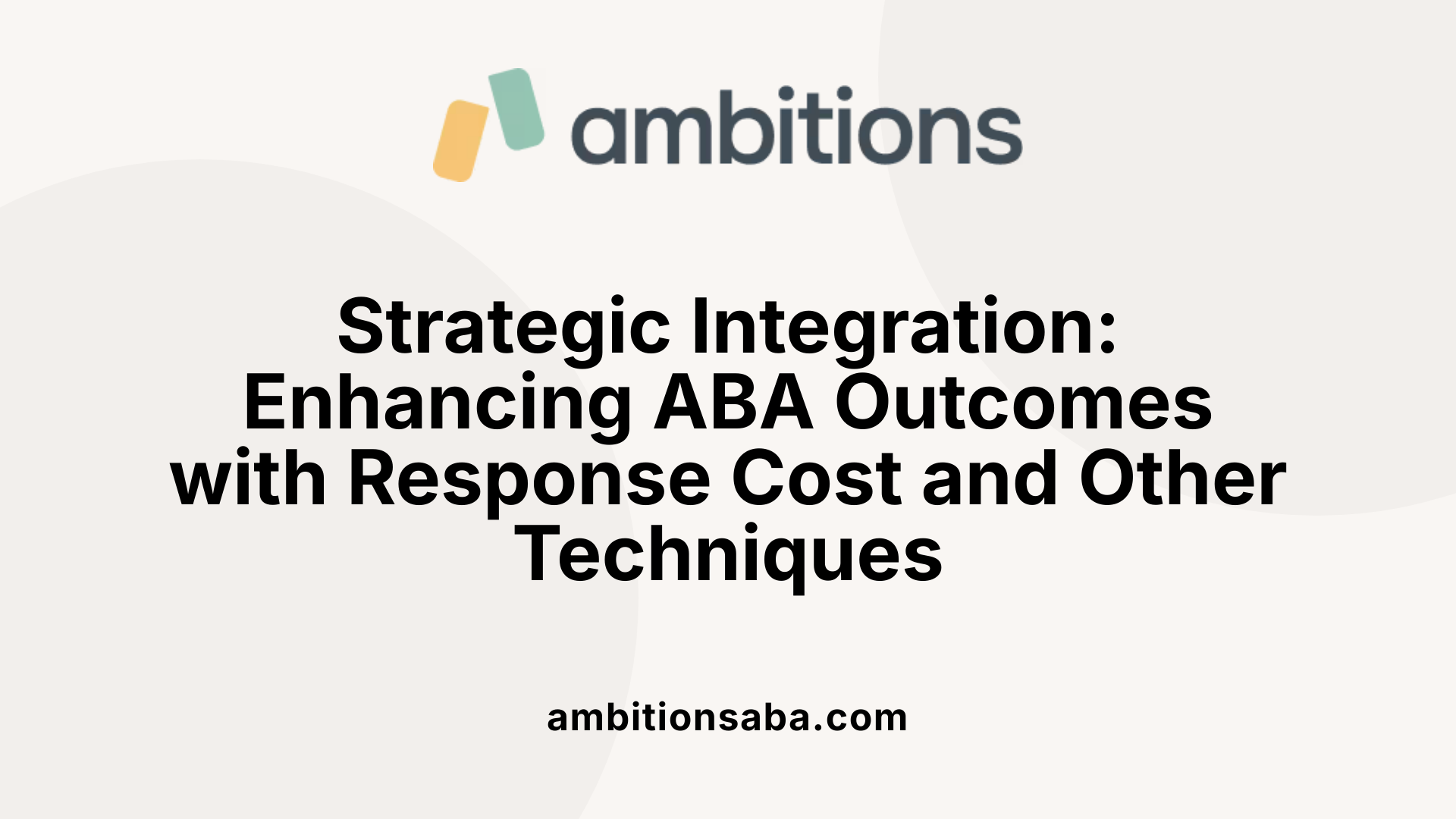
Combining Response Cost with Positive Reinforcement
Response cost is a behavioral strategy where a reward or privilege is taken away following an undesirable behavior, thus decreasing the likelihood that behavior will recur. When integrated properly, response cost can effectively complement positive reinforcement, which focuses on increasing helpful behaviors by providing valued rewards. This dual approach balances consequences with encouragement, helping individuals learn the difference between acceptable and inappropriate behaviors more clearly.
Use Alongside Discrete Trial Training and Pivotal Response Treatment
Response cost is often used alongside established ABA techniques like Discrete Trial Training (DTT) and Pivotal Response Treatment (PRT). DTT involves structured teaching of specific skills in a controlled environment, while PRT emphasizes motivation and naturalistic learning opportunities to enhance pivotal areas such as social motivation and self-management. Integrating response cost within these methods can increase their effectiveness by discouraging problem behaviors, thus improving attention and engagement.
Role in Cognitive Behavioral Therapy Contexts
Although response cost is primarily an ABA technique, its application can extend into Cognitive Behavioral Therapy (CBT) settings as a part of behavioral modification strategies. CBT aims to alter thought patterns and behaviors by recognizing their interconnections. Incorporating response cost can help clients identify the consequences of harmful behaviors, encouraging reflection and adaptation of new coping strategies. This is especially useful in managing anxiety or behavioral issues that arise from rigid thinking, such as those seen in conditions like Pathological Demand Avoidance.
Enhancing Communication and Social Skills
By using response cost thoughtfully, therapists can foster improvements in communication and social skills for individuals with autism spectrum disorder. This approach helps decrease disruptive behaviors that hinder learning and social interaction. When combined with positive reinforcement and evidence-based psychosocial interventions, response cost supports the development of adaptive behaviors and flexibility, essential for better participation in social environments and everyday activities.
Looking Ahead: Improving Outcomes with Response Cost in Autism and Beyond
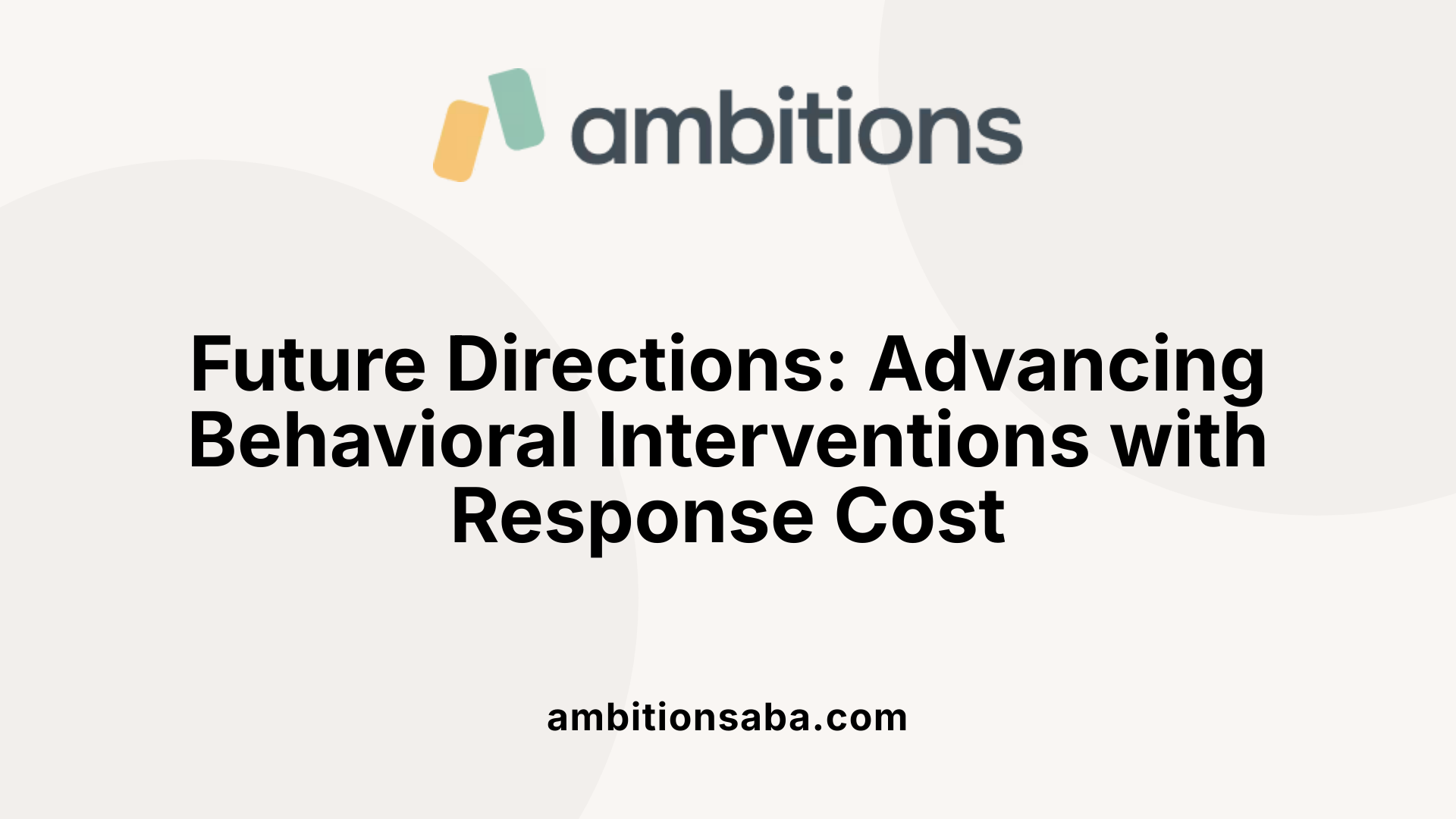
Research Trends in Response Cost Applications
Recent research has expanded the use of response cost beyond its traditional applications in autism therapy, highlighting its role as a valuable behavioral intervention. Studies focus on optimizing how response cost—where a specific positive reinforcer is removed following an undesired behavior—can effectively reduce harmful or impeding behaviors in diverse populations. These trends reflect a growing emphasis on tailoring behavioral approaches to individual needs, ensuring that interventions remain flexible and supportive.
Expansion Beyond Autism Therapy
Although initially grounded in strategies like Applied Behavior Analysis for autism, response cost is increasingly applied across a range of behavioral health contexts. This includes managing behaviors in educational settings, addressing certain challenges linked with mental health conditions, and implementing structured behavior modification programs in various environments such as schools and community centers. The adaptability of response cost enables it to support individuals with diverse profiles, including those with anxiety-related avoidance behaviors seen in Pathological Demand Avoidance.
Collaboration Among Healthcare, Education, and Social Sectors
Effective application of response cost benefits from a collaborative approach across health, education, and social care sectors. Coordinated efforts ensure that interventions are consistent, culturally sensitive, and integrate input from families, professionals, and communities. This holistic partnership enhances outcomes by addressing the broad needs of individuals, promoting seamless access to timely, evidence-based interventions, and facilitating comprehensive support systems tailored to each person's unique behavioral and developmental profile.
Long-Term Benefits and Quality of Life Improvements
Incorporating response cost into personalized behavioral intervention plans offers potential for sustained improvements in communication, social skills, and adaptive behaviors. Over time, these gains contribute to better academic performance, more meaningful social interactions, and increased independence. Ultimately, strategic use of response cost can enhance overall quality of life, helping individuals navigate complex social demands and reduce anxiety related to behavioral challenges, thereby supporting their well-being across the lifespan.
Summary and Future Perspectives on Response Cost in Behavioral Therapy
Response cost plays a pivotal role within the spectrum of behavior modification techniques used in Applied Behavior Analysis, especially in treating autism and related behavioral challenges. By effectively reducing harmful or disruptive behaviors while promoting positive development, it complements reinforcement strategies and supports individualized therapy goals. The success of response cost interventions relies heavily on qualified professionals trained in ethical and evidence-based practices. As research advances and multidisciplinary collaboration grows, response cost continues to be a valuable tool in enhancing the lives of individuals with autism and other behavioral needs, emphasizing the importance of personalized, respectful, and comprehensive care.
References
- How Does ABA Therapy Work
- Cognitive behavioral therapy
- Pathological Demand Avoidance (PDA) in Kids
- Autism
- Autism Spectrum Disorder (ASD) Symptoms & Causes
- How to Become an Applied Behavior Analyst (ABA) Therapist
- Your Complete Guide to Becoming an ABA Therapist
- How to Become an ABA Therapist - School of Education
- Applied Behavior Analysis (ABA)

